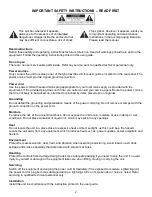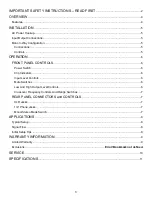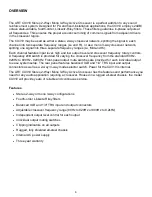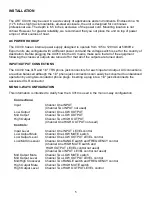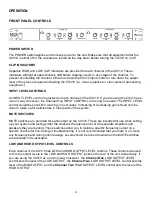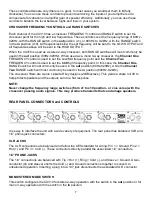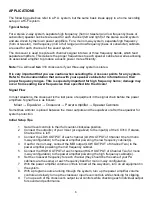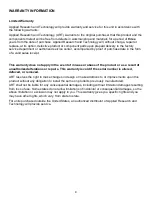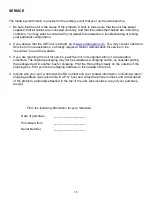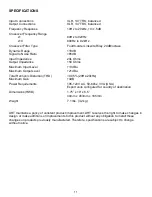
8
APPLICATIONS
The following guidelines refer to a P.A. system, but the same basic ideas apply to a home recording
setup or a Hi-Fi system.
Typical Setup
For a stereo 2-way system, separate high frequency (horn or tweeter) and low frequency (bass or
subwoofer) speaker cabinets are used for each channel (left and right) of the stereo sound system
and are driven by their own power amplifiers. For a mono 3-way system, separate high frequency
(horn or tweeter), mid frequency (mid or full range) and low frequency (bass or subwoofer) cabinets
are used for each channel of the sound system.
The crossover is used to split each channel's signal into two or three frequency bands, which feed
separate amplifiers. This delivers the proper frequencies to each speaker cabinet as well as allowing
its associated amplifier to produce acoustic power more efficiently.
Note:
You will need
two
310 crossovers if your three-way system is stereo.
It is very important that you use caution when selecting the crossover points for any system.
Refer to the documentation that came with your speaker cabinets for information on their
proper frequency ranges. This is especially important for high frequency horns; damage may
occur from sending lower frequencies than specified into the drivers!
Signal Flow
In most situations, the crossover is the last piece of equipment in the signal chain before the power
amplifiers. Signal flow is as follows:
Mixer → Equalizer → Crossover → Power Amplifier → Speaker Cabinets
Sometimes a limiter is placed between the mixer outputs and the equalizer or after the equalizer for
system protection.
Initial Setup Tips
1. Set all level controls to their full counter-clockwise position.
2. Connect the output(s) of your mixer (or equalizer) to the input(s) of the CX310. If stereo,
Channel One is left.
3. Connect the LOW OUTPUT of each channel (LOW OUTPUT of Channel One for mono
3-way configuration) to the power amplifier powering the low frequency cabinet(s).
4. If set for mono 3-way, connect the MID output (LOW OUTPUT of Channel Two) to the
power amplifier powering the mid frequency cabinet.
5. Connect the HIGH OUTPUT of each channel (HIGH OUTPUT of Channel Two for mono
3-way configuration) to the power amplifier powering the high frequency cabinet(s).
6. Set the crossover frequency for each channel (they should be the same if your PA
cabinets are the same) or each frequency band for mono 3-way configuration.
7. With the power amplifier volume controls turned all the way down, turn on all equipment in
the system.
8. With a program source running through the system, turn up the power amplifier volume
controls and slowly turn up the crossover input level controls while checking for clipping.
9. Turn up each of the crossover's output level controls while checking each individual output
for sound and performance.


